Easy Italian ‘un-recipes’ for big garlic and big onion that could change your summer cooking
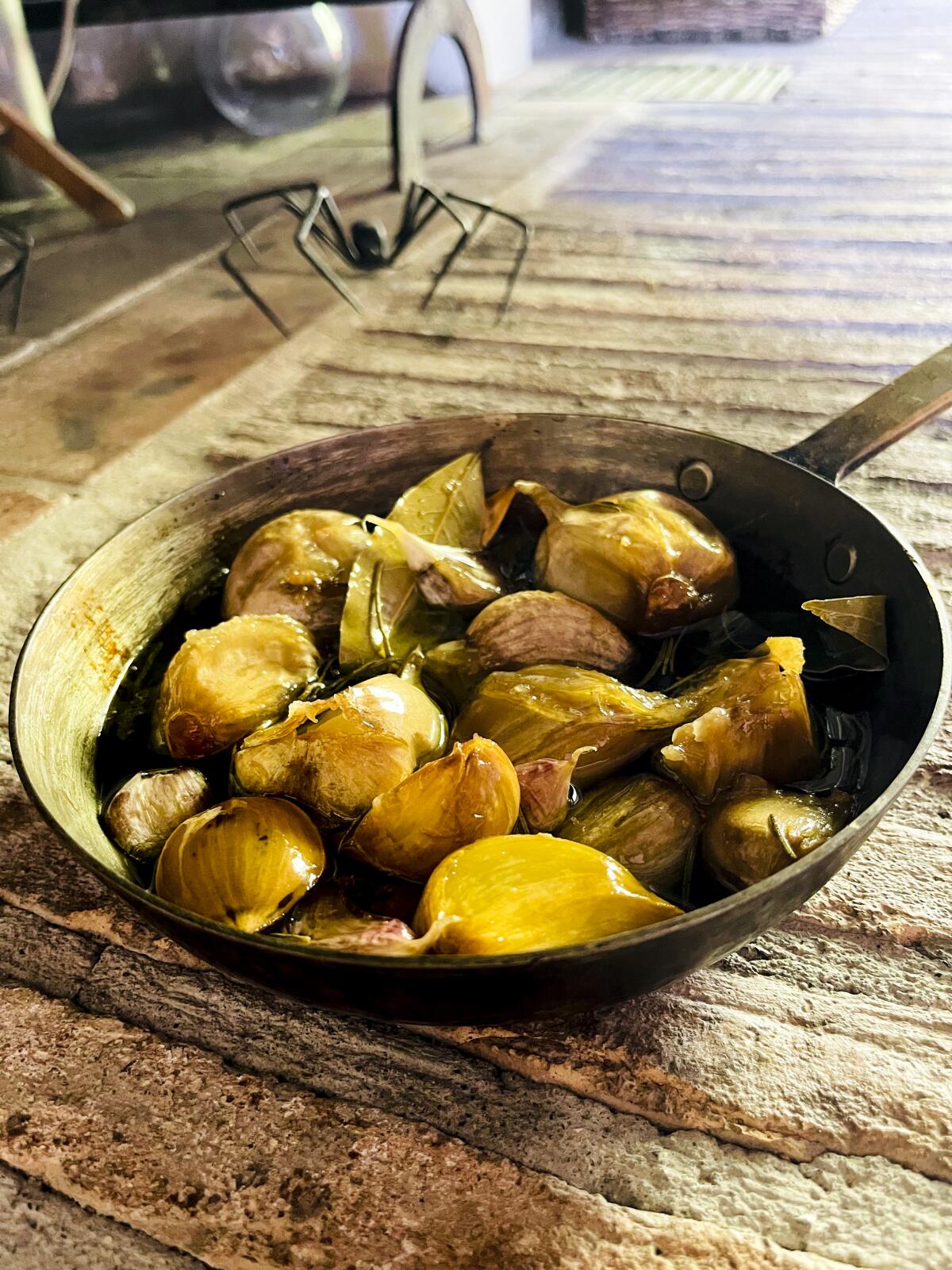
PANICALE, Italy — Big onions, big garlic and getting flavor out of big seedless watermelon. I’m Laurie Ochoa, general manager of L.A. Times Food, filling in for vacationing columnist Ben Mims with this week’s Cooking newsletter.
Florence’s best table
When you step into the Florence home of Faith Willinger and Massimo Tarli, there is no doubt that a cook’s spirit inhabits the place. Around a corner and down a few steps, you’ll find a rather elegant living room inside their apartment on the so-called other side of the Arno River — the Oltrarno. But the real living happens at the long wooden table that dominates the dining room and kitchen space, which manifests like a cook’s dream as soon as the door opens. Bulbs of garlic, strings of dried chiles and cured meat hang from a massive hearth that is joyously cluttered with bottles of olive oil, wine and jars of condiments acquired during Willinger and Tarli’s latest travels around Italy. Framed images of friends, foods and an artist’s series of cooks’ faces line the walls, along with an arrangement of author Willinger’s latest collection — portraits of Sicilian fish by architect and artist Fabrizio Foti.
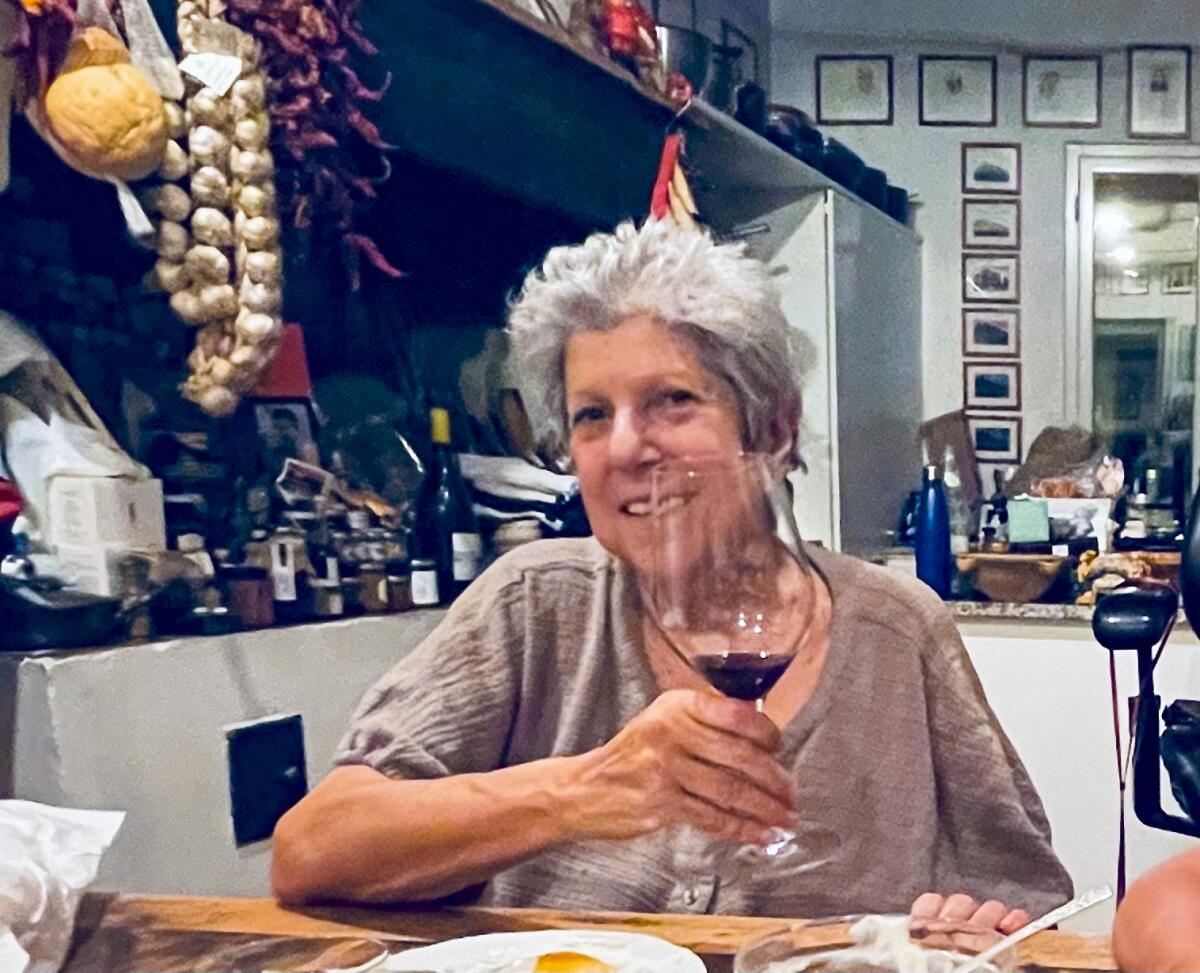
If you’ve been lucky enough to score a seat at what many chefs and food professionals call the best table in Florence, you will find yourself settling into a comfortable molded plastic Bellini chair made by the design manufacturing firm Heller, started by Willinger’s late brother, Alan Heller. Their father, Jacob, known as Jack, was also a design manufacturer, most notably of the Heller Hostess Ware Colorama line of anodized aluminum tumblers, a set of which is lined up in rainbow colors on a shelf in Willinger’s kitchen.
You might think of Willinger and Tarli’s home cuisine as another kind of collection. Every dish that Tarli presented, with Willinger directing the action from the head of the table, contained an ingredient from research trips done for the author’s books, articles or web posts, or came with a story about a favorite chef or technique.
Consider her very Italian take on deviled eggs with perfect, jammy yolks dressed with tonno del Chianti — pork preserved in olive oil, as if it were tuna — made by her close friend the Tuscan butcher Dario Cecchini. Or her caponata made with honey from Sicily instead of sugar and almonds instead of pine nuts. Or the varieties of jumbo Sicilian onions — Giarratana, Partanna and Paglina — that Willinger recently wrote about on her website. On this night she drizzled the big onions with extra virgin olive oil, topped them with bread crumbs and baked them in a dish sent to her by Los Angeles restaurateur and cookbook author Nancy Silverton — who happened to be sitting at the table and was the reason I was able to tag along for dinner at Willinger and Tarli’s apartment.
Willinger, who calls herself a born-again Italian but still loves great American baking, asked Silverton if she would bring homemade biscuits to go with the preserved apricots she’d been given by famed pizza chef Franco Pepe (who uses them on a fantastic dessert pizza at his restaurant outside Naples in Caiazzo). Willinger, using what she sometimes calls an “un-recipe” approach to cooking — relaxed and ever adaptable — served Silverton’s biscuits with Pepe’s apricots and, in place of whipped cream, a bowl of plain yogurt that she had dusted with lemon zest. She then invited us to assemble our own desserts. It was a simple but memorable way to end a meal made of simple but memorable dishes.
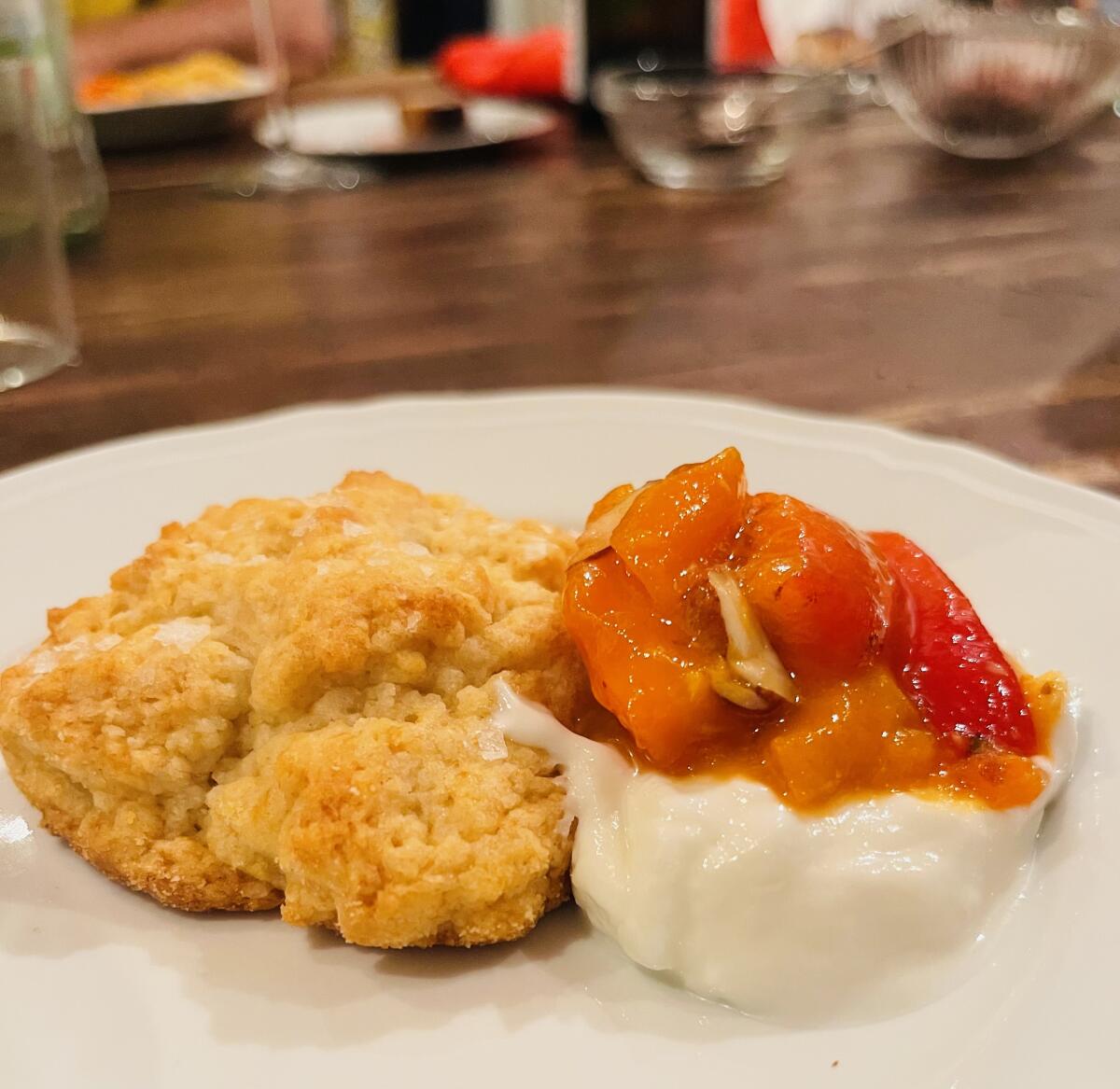
Faith Willinger’s un-recipe for onion steaks
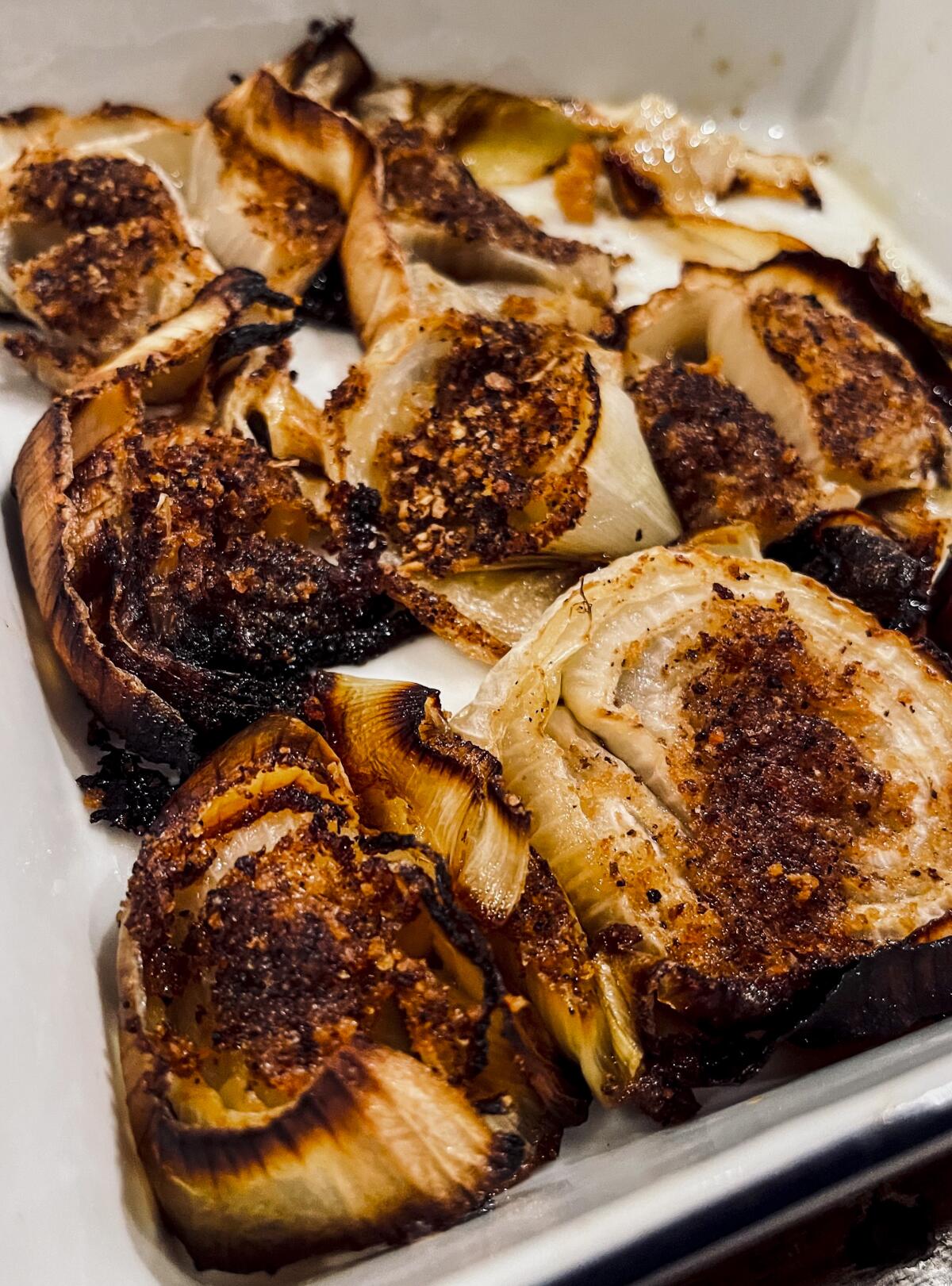
Peel onions and cut into slices about 1-inch thick. Place the slices on a parchment-paper-lined baking sheet, season lightly with salt and pepper, drizzle with extra virgin olive oil and sprinkle with breadcrumbs. Bake at 350 degrees until browned. Serve hot or at room temperature.
For two other big onion un-recipes from Willinger, see her blog post titled “Three Giant Sicilian Onions, Three Un-Recipes.”
Big garlic, big flavor
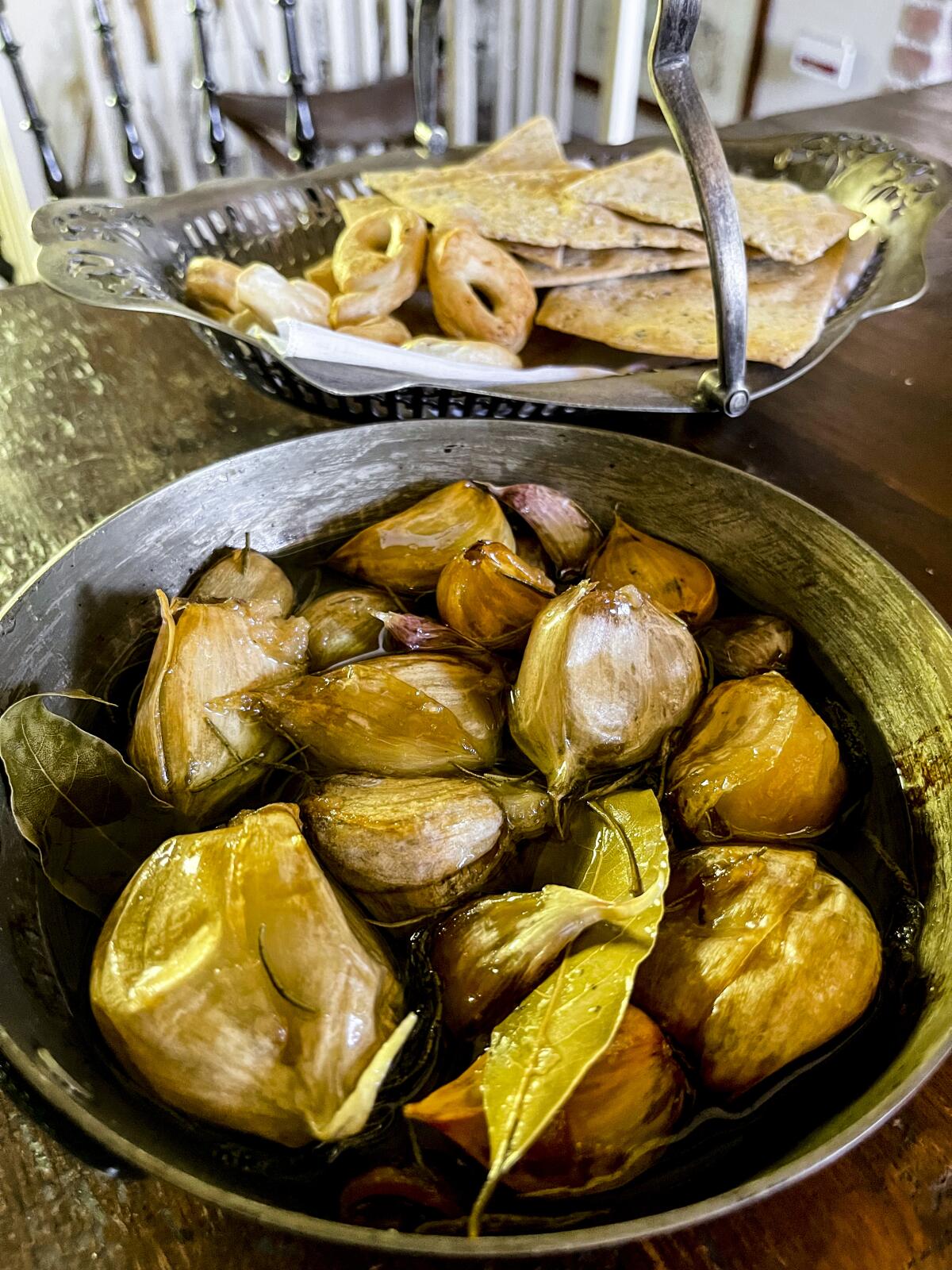
“Simple but memorable” not only describes Faith Willinger’s cooking approach but also that of many of Italy’s best chefs. It’s why for more than 20 years Nancy Silverton has made a second home for herself in Panicale, a town in the Umbrian hills above Lake Trasimeno.
Just as Alice Waters’ connection with the cooking of France shaped California cuisine, Silverton’s explorations of Italy from her Panicale base — and her earlier immersion in Tuscan cooking near Lucca when she and her late ex-husband Mark Peel were developing their influential restaurant Campanile — have helped shift the way we eat in Los Angeles. Sometimes one of her “take-homes” for her Mozza restaurants will be inspired by a new approach she encounters to a traditional dish. At the tiny, art-filled La Bottega di Assù in the Umbrian town of Bevagna, for instance, there is a panzanella that reverses the usual proportion of bread to vegetables. Instead of bread crumbs dominating the dish, La Bottega piles tomatoes, celery, chopped bell pepper, olives, basil and more atop a piece of bread and adds a ball of fresh mozzarella drizzled with olive oil. Silverton, of course, instantly recognized that this update on tradition was a natural for Southern Californians looking for a new kind of salad.
This year, chef Liz Hong, culinary director of the Mozza group and Silverton’s trusted sounding board on all things food-related, came along to Italy and took the lead on developing a style of garlic confit you’ll see in various guises at Mozza in the coming months — and which you can work into your own cooking. The inspiration was Tuscan big garlic, often called aglione di Valdichiana, a variety in which each bulb can be as large as a regular head and which is said to go back to Etruscan times. Hong loved cooking with the bigger cloves, which she says release more starch than regular garlic, making it perfect for coating pasta — as they do at Massimo Giovannini’s wonderful La Vecchia Rota in Marciano near Arezzo.
Aglione isn’t readily available in Los Angeles, but for a party in Panicale Hong made a confit with different sizes of garlic and loved the contrast between the huge aglione cloves and smaller cloves. She and Silverton agree that larger elephant garlic cloves would be a workable substitute in Los Angeles for Tuscan aglione. “It looks so beautiful,” Hong says, “with big cloves and little and medium cloves nestled on a plate.”
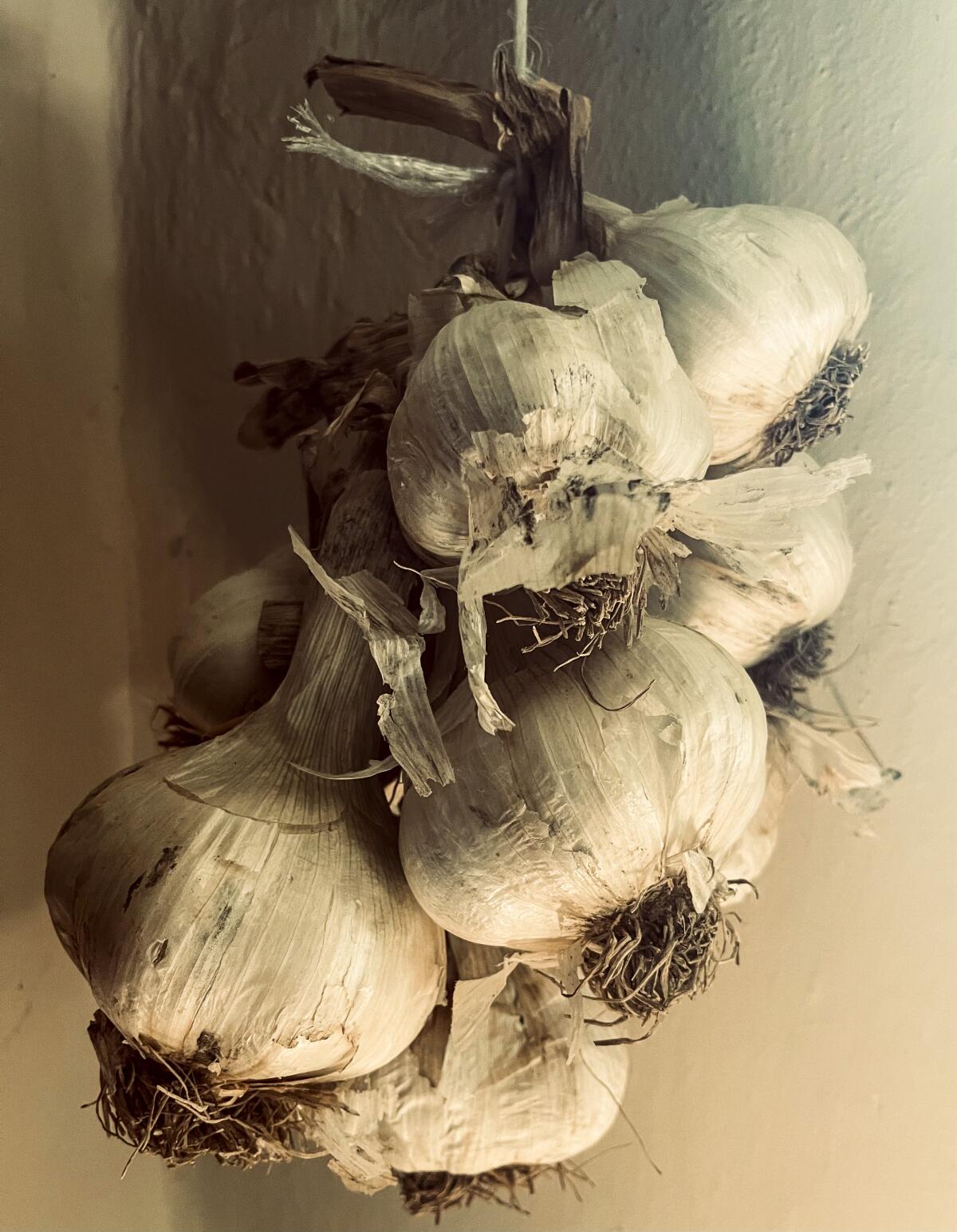
You not only get soft cloves of garlic — of the type that everyone goes for when you cook a roast and throw in a head of garlic — but also wonderfully flavored oil. The confit can become your new best friend in the kitchen, whenever you need a jolt of flavor or just want a quick, delicious snack. Here’s how Hong makes her confit:
Liz Hong’s un-recipe for big garlic confit
“Take beef fat, pork fat, the fatty end of a prosciutto,” Hong says. “Anything that has a lot of fat on it.”
“Steak fat,” Silverton adds.
“Sear it in a deep pot at a super-high temperature,” Hong continues, “and just render the fat off of that piece of meat until you get a nice layer of fat swimming around in your pot. That oil’s going to be really, really hot and bubbly; you add some chile pods, maybe chile de arbol, your herbs — rosemary sprigs, sage stems, fresh bay leaves ... “
“Whatever’s growing in your front patio,” Silverton adds in true un-recipe style.
“That starts bubbling,” Hong continues. “Turn the heat all the way down, as low as it goes, add your garlic cloves with the skin on, and then you take decent olive oil, cover it all the way to the top of the garlic cloves and just let it simmer, simmer, simmer, simmer. Like the lowest fire that you have. Depending on how big your garlic cloves are, it will take about 45 minutes. And you’ll know when it’s completely soft. But you don’t want it to get so soft that it explodes in the oil. Take it off the heat just when it’s super fork-tender or when you mush it with your fingers you can tell that it’s soft inside.”
Serve the confit cloves peeled in pasta, unpeeled with steak or especially squeezed onto toasted crusty bread or good crackers.
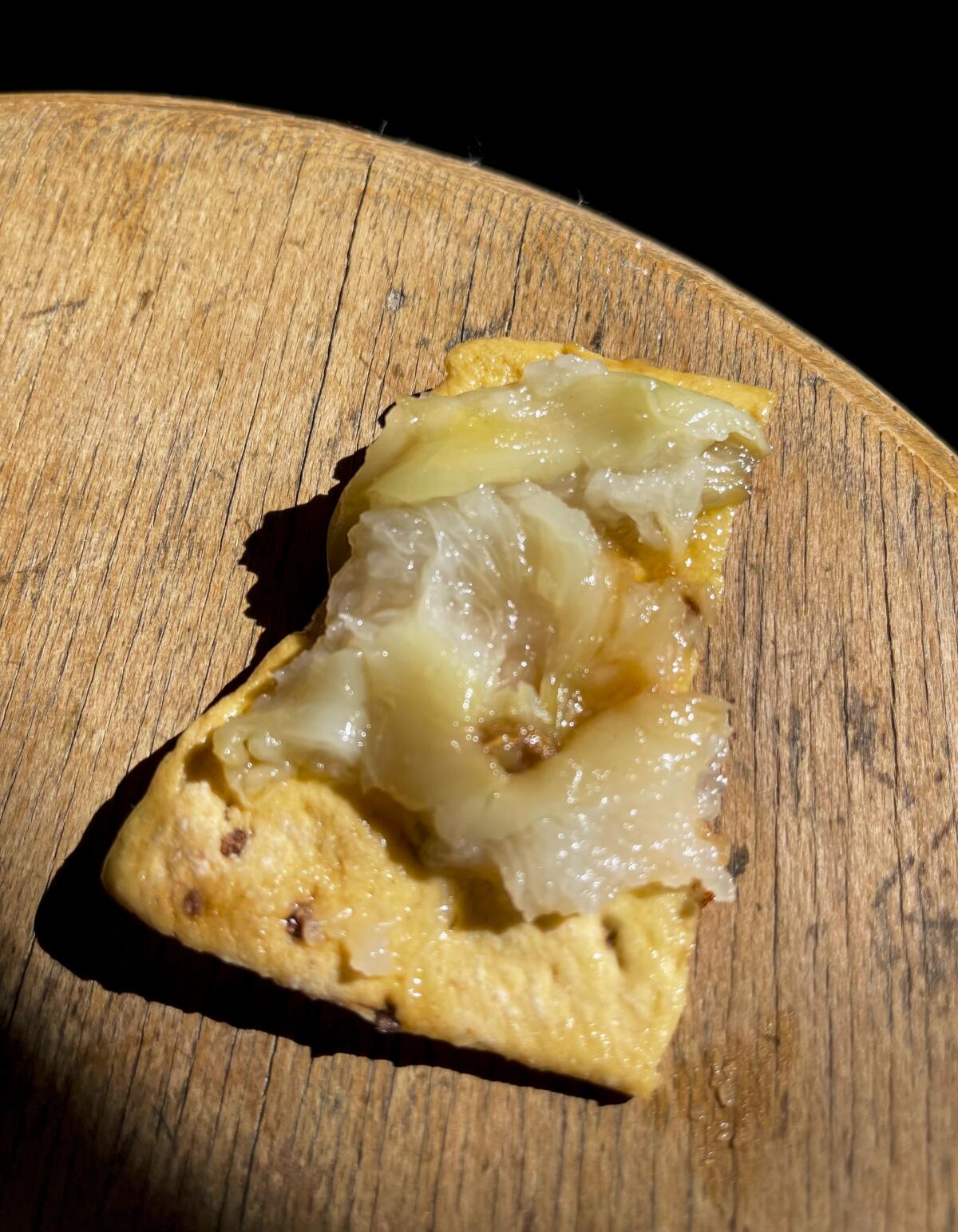
Get our Cooking newsletter.
Your roundup of inspiring recipes and kitchen tricks.
You may occasionally receive promotional content from the Los Angeles Times.
Ben Mims’ watermelon flavor fix
Did watermelons lose their flavor when they went seedless? Many scientists say no. But Times cooking columnist Ben Mims says that most of the watermelons he buys at the market just don’t taste the way he remembers growing up in the South. So he’s borrowed a technique used for getting the moisture out of eggplant and cucumbers and uses salt and sugar on top of cubed watermelon to draw out the liquid and concentrate the flavor. Read all about his technique for giving even the most pallid watermelon a flavor boost.
Spicy Watermelon and Tahini Salad With Pistachios and Mint
With his flavor-boosted watermelon, Mims came up with a different kind of summer salad that uses tahini, mint, jalapeño slices, pistachios and toasted cumin and coriander seeds.
Get the recipe.
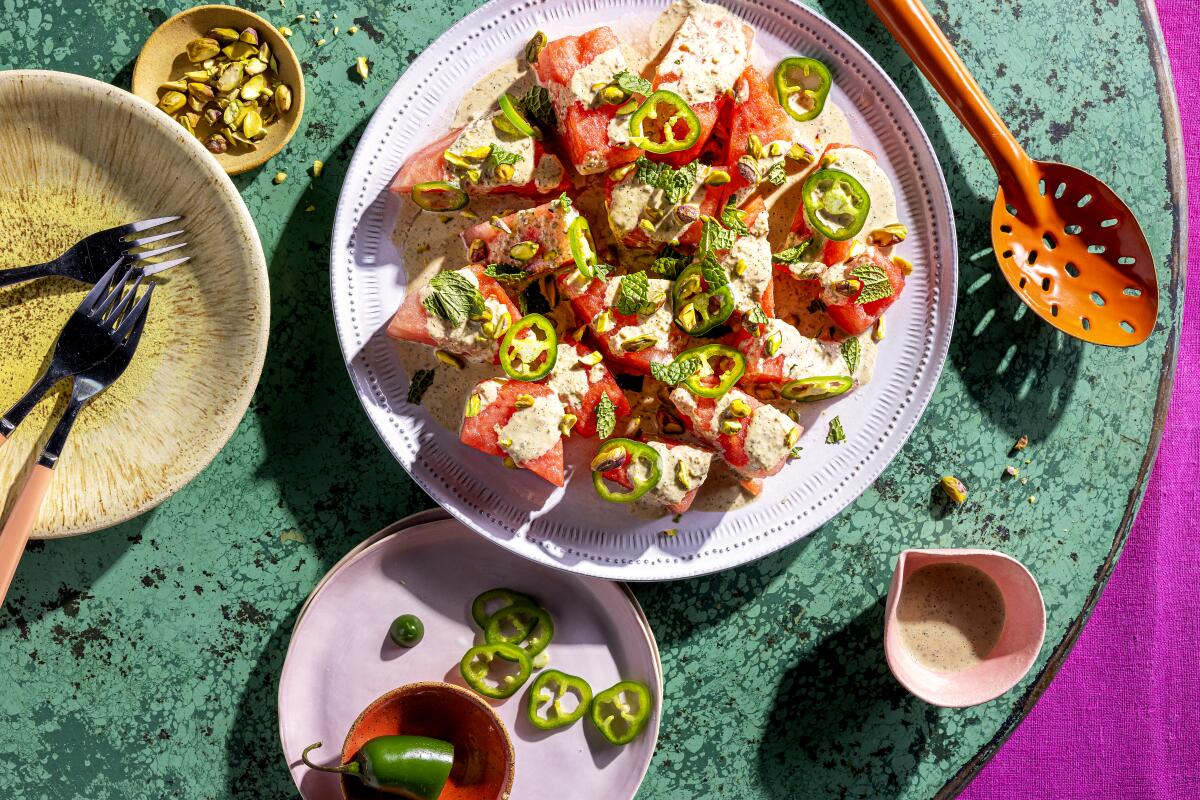
Enjoying this newsletter?
Consider becoming a Times subscriber.
Making the most of eggplant season
Eggplant always seems to be in the market, but as Julie Giuffrida writes, its season locally really only lasts from July through September. To get the most out of seasonal eggplant, she went through The Times’ archives and chose eight great recipes, including an eggplant timbale and Taiwanese-style wok-cooked eggplant.
Get the recipes.
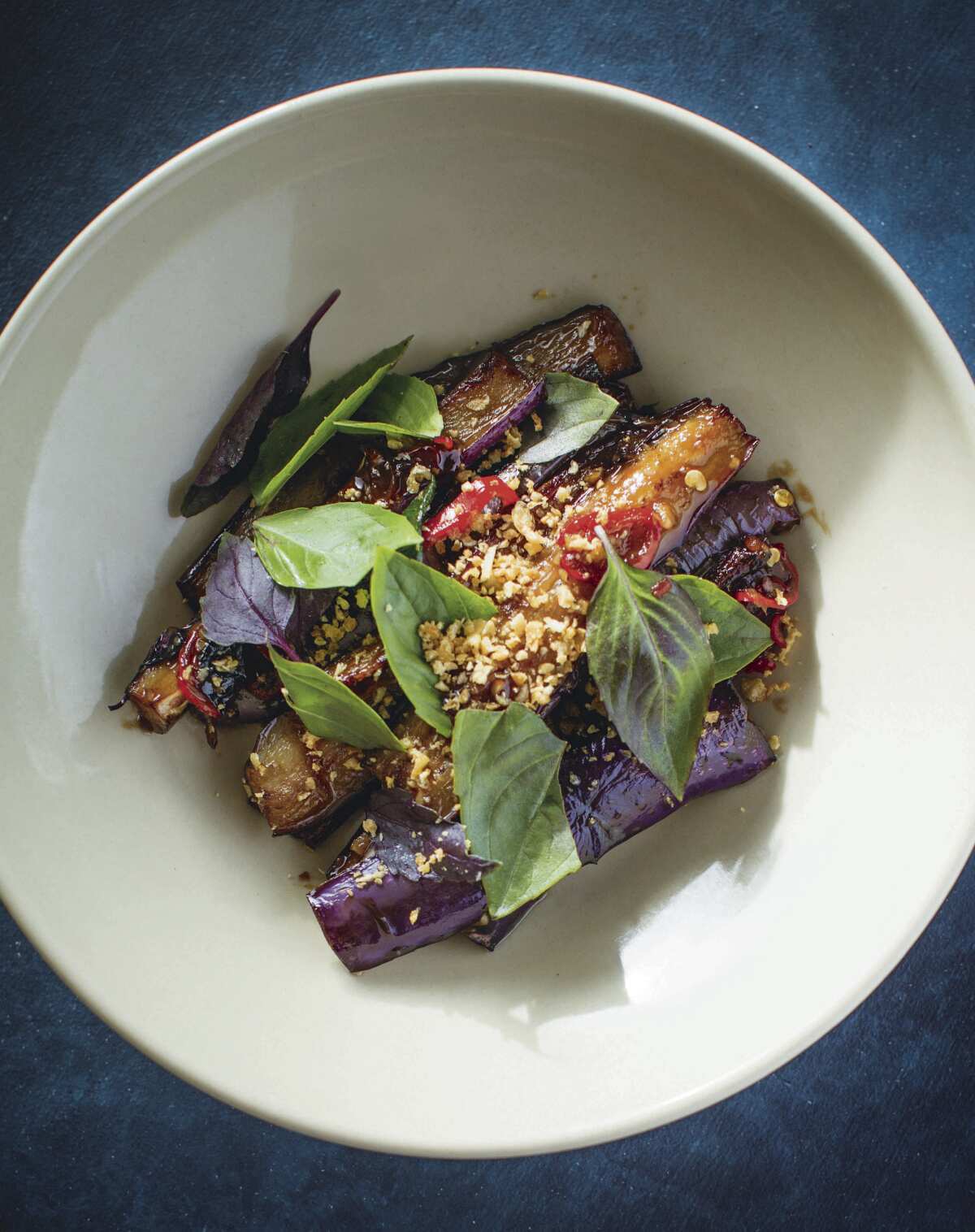
Have a cooking question?
Eat your way across L.A.
Get our weekly Tasting Notes newsletter for reviews, news and more.
You may occasionally receive promotional content from the Los Angeles Times.




